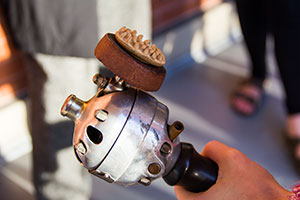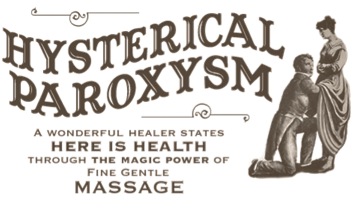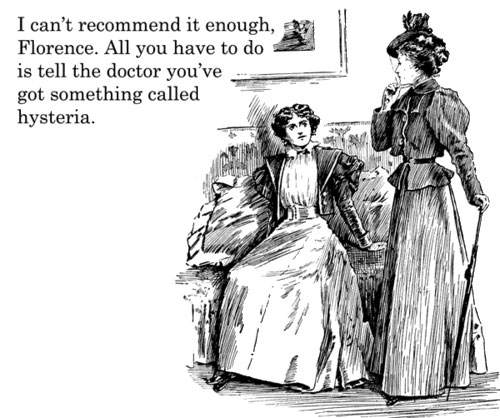Hysterical?

Miami University Theatre's production of "In the Next Room or The Vibrator Play" deals with subject matter of women and hysteria in the Victorian age
By Talia Abrams
A mental disorder? If so, every “Cosmo-reading,” “Magic Mike-Loving,” or even just emotional women would be diagnosed. Symptoms the women experienced include irritability, fatigue, mild depression, insomnia, anxiety, and sexual desire. With that said, it was no surprise thousands of Victorian-era women experienced these common symptoms and when they did, they were diagnosed with hysteria—a disease. 
Miami University department of theatre is excited to delve into the topic of hysteria (and it’s cure) live onstage in their production of “In The Next Room, or the vibrator play,” opening Wednesday, October 21. Student Alexandra Fair shared her insight on the topic as well. ”One of the things that I find especially fascinating about gender and sexuality studies is how medicine and scientific studies have been used to define what is ‘natural’ or ‘normal’ and how these definitions have changed overtime. Given this, it is easy to watch the play or study hysteria and vibrators through a present perspective and fall into the trap of thinking how wrong and silly we think the doctors at the time were,” she said.
I asked her: Based on your research about hysteria, what do you think the play will make the audience think about? How does representing hysteria on the stage provide new insights, and she replied “The play is supposed to be funny but more than that, we should watch the play and use it as an opportunity to question how medical knowledge gets constructed and whose experiences are valid within the medical system?”
 Many doctors practiced new medical techniques on their female hysterical patients to try to cure them. Often the women were prescribed a manual “pelvic massage” by a clinician meaning to cause a “hysterical paroxysm,” what we now all know as an orgasm. The clash of the hysteria outbreak and the dawn of electricity brought about the vibrator, a revolutionary technology that would induce these paroxysms with even greater success. Because this was a medical treatment, it didn't have the same social and cultural connotations it does today. We tend to think we are more progressive and less reserved nowadays than in the 19th century, yet the word “vibrator” is never to be uttered in a conversation—it’s uncomfortable and impolite. This goes to show you how socially constructed sexuality is! Sarah Rhul’s “IN THE NEXT ROOM, or the vibrator play,” depicts the life of Dr. Givings and his wife when he begins treating women with paroxysms with the new vibrator. At the “Pouring Tea” event at Patterson Place on the historic Western Campus, there was a real historic vibrator. “I ordered the vibrator from eBay so that the students could see what an antique vibrator might have looked like” Fair said. This just goes to show you how far we have come in the age of technology. “Certainly I thought it would be harder to locate an antique vibrator than it was” she shared.
Many doctors practiced new medical techniques on their female hysterical patients to try to cure them. Often the women were prescribed a manual “pelvic massage” by a clinician meaning to cause a “hysterical paroxysm,” what we now all know as an orgasm. The clash of the hysteria outbreak and the dawn of electricity brought about the vibrator, a revolutionary technology that would induce these paroxysms with even greater success. Because this was a medical treatment, it didn't have the same social and cultural connotations it does today. We tend to think we are more progressive and less reserved nowadays than in the 19th century, yet the word “vibrator” is never to be uttered in a conversation—it’s uncomfortable and impolite. This goes to show you how socially constructed sexuality is! Sarah Rhul’s “IN THE NEXT ROOM, or the vibrator play,” depicts the life of Dr. Givings and his wife when he begins treating women with paroxysms with the new vibrator. At the “Pouring Tea” event at Patterson Place on the historic Western Campus, there was a real historic vibrator. “I ordered the vibrator from eBay so that the students could see what an antique vibrator might have looked like” Fair said. This just goes to show you how far we have come in the age of technology. “Certainly I thought it would be harder to locate an antique vibrator than it was” she shared.
This play has multiple elements and themes, and there is truly something that can appeal to every audience member. Come watch the characters delve into the ideas of sexuality, electricity, intimacy, and discovery in this witty and humorous, yet tender and touching play. Please note: This production includes material of an adult nature and may contain brief nudity. Audience members under the age of 18 will not be admitted without parental consent. Potential audience members who are concerned about whether it is appropriate for them should contact the Department of Theatre at 513-529-3053 for additional information. “In the Next Room, or the vibrator play” Written by Sarah Ruhl and Directed by Ann Elizabeth Armstrong will run October 21-24, 2015 at 7:30 p.m. and October 25, 2015 at 2:00 p.m. in Gates-Abegglen Theatre. Tickets: $12 Adult, $9 Seniors, $8 Students.

